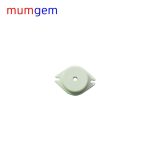Zirconia ceramic powder is a high-performance ceramic raw material mainly composed of zirconium dioxide (ZrO ₂), and its properties are closely related to the preparation process. The following is a summary of key information:
1. Basic characteristics
Composition: The main component is ZrO ₂, and stabilizers such as yttrium oxide (Y ₂ O3) are often added to suppress crystal transformation, forming yttrium stabilized tetragonal (YSZ) or cubic phases.
Physical properties: high melting point (2715 ℃), high hardness (HV1250), excellent wear resistance and toughness, and improved mechanical properties through phase transformation toughening mechanism.
Application areas: Widely used in dentures, sensors, lithium battery additives, wear-resistant coatings, and optical devices.
2. Preparation method
Chemical method: including coprecipitation method, hydrothermal method, sol gel method, etc. The co precipitation method has low cost but is prone to agglomeration, while the hydrothermal method can produce nanoscale powders but requires high equipment requirements.
Physical methods: such as mechanical grinding, suitable for the preparation of coarse powders.
Encapsulation precipitation method: By uniformly encapsulating stabilizers (such as Y ₂ O ∝) on the surface of zirconia powder, sintering activity is enhanced.
3. Powder performance control
Particle size control: nanometer powder (20-50nm) can be prepared by micro lotion method, with a specific surface area of 33.13m2/g, and the calcination temperature affects the surface organic residue and Zeta potential.
Dispersion: pH adjustment can optimize suspension stability, with an isoelectric point of approximately pH=6 and a higher negative potential under alkaline conditions.
4. Market and Price
Price range: The price of nanoscale zirconia powder is approximately ¥ 100-350/kg, depending on purity, stabilizer content (such as 3mol% YSZ), and supplier.
Supplier examples: Hangzhou Hengge, Wuhu Xinda, etc. provide different specifications of powders and support dropshipping.
5. Key process requirements
Powder quality: Low impurities and high dispersibility are required to avoid hard agglomeration, otherwise it will affect the forming and sintering density.
Sintering process: Non pressure sintering or hot isostatic pressing (HIP) is commonly used for densification, with temperatures typically below 1500 ℃.


评价
目前还没有评价